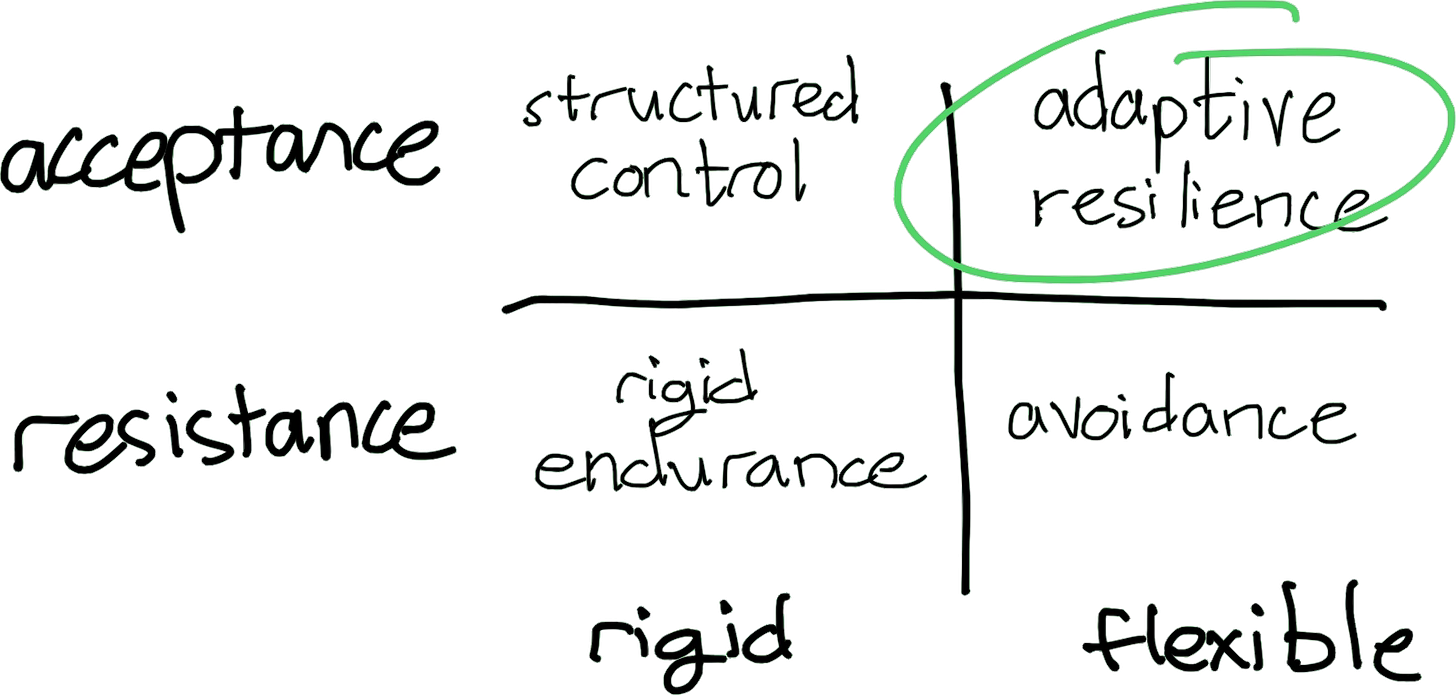The future doesn’t belong to the smartest or strongest—it belongs to the most adaptable.
Here’s how to build that kind of power.
When continuous disruption becomes the new normal, a profound question emerges: Why do some people, organizations, and systems not just survive change, but emerge stronger from it?
The Perception Paradox
We’ve got new diseases. AI is disrupting industries. The economy is in turmoil. The environment is unstable. Over 120 million people will be displaced globally this year.
Nations are at war. Trade is disrupted. Cybersecurity is a threat. Democracy is threatened.
Social and political polarization affects everyone.
It seems like everything’s falling apart.
The pursuit of resilience begins with a paradox: to navigate the world effectively, we must first see how systematically terrible our perception naturally is. Cognitive science shows us how our perception isn't a direct window to reality but a constructive process shaped by biases, filters, and shortcuts.
As Nobel laureate Daniel Kahneman demonstrated in his groundbreaking research, our minds operate in two systems: fast, intuitive thinking (System 1) and slow, deliberate reasoning (System 2). System 1 dominates our perception, creating systematic patterns that are hard to change even when we try—like optical illusions that remain puzzling even after we understand their mechanics.
This perceptual reality creates our first challenge in building resilience: we cannot navigate effectively what we cannot see clearly.
My Journey to Adaptive Resilience
I didn't set out to study resilience. It found me through necessity.
When I was very young, growing up in America, the health system failed me. I had to recover with no help and no roadmap. What began as personal survival became a seed that once planted would grow into a systematic exploration of how people adapt and thrive through adversity.
As a young man, I studied complex systems and worked in artificial intelligence—then a nascent field of research. I observed something revelatory: the strategies that helped people rebuild after personal setbacks mirrored those that helped organizations navigate industry disruption, that helped communities recover from disasters, and that helped ecosystems adapt to environmental changes.
This wasn't coincidence. It was a pattern—a universal process I've come to call Adaptive Resilience.
Like Forests After Fire: Regeneration In The Age of Collapse
Most people misunderstand resilience. They think it means staying strong and enduring hardship, bouncing back to normal, or building cathedrals to control what cannot be controlled.
But true resilience—Adaptive Resilience—isn't about returning to what was. It's about evolving into something better.
Consider the forest after fire.
It doesn't merely regrow what burned—it transforms.
New species emerge. The soil replenishes. The ecosystem reorganizes.
The forest that returns is not the same—often more diverse, more stable, and better equipped for the next challenge.
This pattern appears across scales—from individual healing to global systems. The most resilient entities don't just recover; they use disruption as a catalyst for meaningful transformation.
The Four Pillars Framework: A System of Capabilities
Through years of research and personal experience, I've identified that Adaptive Resilience isn't a single trait but an integrated system of capabilities resting on four essential pillars:
1. Clarity: How To See What’s Really There
“We don’t see things as they are, we see them as we are.”
— Anaïs Nin
Most of us don’t see the world as it is—we see it as we expect it to be.
That gap is where bad decisions, burnout, and breakdowns are born.
Clarity represents our capacity to see reality as it truly is, not as we wish it to be. It begins with recognizing our cognitive biases—those systematic distortions in perception that Julia Galef describes as the difference between “soldier mindset” (defending pre-existing beliefs) and “scout mindset” (seeking accurate understanding regardless of implications).
Research by Elizabeth Pronin at Princeton revealed what she calls the “bias blind spot”—our tendency to recognize cognitive biases in others while remaining oblivious to the same biases in ourselves. This metacognitive challenge forms the most important obstacle to clarity.
Yet Clarity is more: it is a multidimensional discipline involving perception, presence, systems awareness, emotional integration, and even moral courage.
Clarity encompasses:
Perceptual accuracy: Seeing both external and internal reality with minimal distortion
Decisional clarity: Making sound choices despite incomplete information
Strategic clarity: Maintaining direction amid constant distraction
2. Strength: How To Build Resources for Sustained Effort
“Nada se construye sin cimientos, ni se vive sin costumbre.”
“Nothing is built without a foundation, nor lived without ritual.”
—Juan José Arreola
Strength provides the resources required for sustained adaptation. Far broader than mere physical force, it encompasses:
Physical strength: The body's resilient foundation, and energetic capacity
Mental strength: Cognitive flexibility and attention control
Emotional strength: Regulation and integration of feelings as intelligence
Financial strength: Material security that preserves options during disruption
This multidimensional approach to strength ensures resources remain available when they're most needed—during periods of challenge and change.
3. Flow: How To Move With Rather Than Against Change
“天下莫柔弱於水,而攻堅強者莫之能勝。”
"Nothing in the world is more gentle and yielding than water. Yet nothing is more powerful in breaking down the hard and unyielding."
—Laozi
Flow enables dynamic movement with changing conditions rather than rigid resistance.
Flow includes:
Adaptive capacity: Evolving effectively with changing circumstances
Purpose alignment: Finding meaning within challenge rather than despite it
Growth orientation: Converting disruption into development
This dynamic dimension transforms our relationship with change from adversarial to cooperative, allowing us to harness rather than resist its energy.
4. Connection: How To Build Support and Meaning That Sustain Motivation
“I dream of a day when people can live in peace. A day when we all understand that we are connected.”
— Keanu Reeves
Connection provides the relational foundation that supports resilience across scales. Research consistently shows that social support represents perhaps the strongest predictor of positive outcomes during adversity.
Connection encompasses:
Interpersonal connection: The direct support of meaningful relationships
Systemic connection: Integration with broader communities and contexts
Transcendent connection: Finding purpose beyond immediate circumstances
This relational dimension reminds us that resilience never develops in isolation—it emerges through our connections with others, with systems, and with sources of meaning beyond ourselves.
Why This Matters Now
The challenges we face today aren't temporary disruptions before a return to “normal.” They're fundamental transformations reshaping how we work, live, relate, and create meaning:
Mass disconnection is fueling a silent epidemic of despair, burnout, and breakdown
We’ve lost our shared reality—and with it, our ability to act together
Chronic stress is overwhelming our bodies, immune systems, and collective capacity to heal
Our systems can’t keep up with the scale or speed of today’s change
Ecological degradation is accelerating, and with it, paralyzing fear, denial, or disconnection
These aren't isolated problems to solve and move past. They represent the context within which we must learn to adapt and flourish.
What You'll Find in Adaptive Resilience
Each week, I'll explore a facet of Adaptive Resilience through:
Evidence-based frameworks drawn from cutting-edge research across disciplines
Practical applications you can implement immediately
Case studies of exceptional adaptation in individuals and systems
Integration strategies that help you build all four pillars simultaneously
Some weeks will focus on personal resilience—how to navigate career disruption, health challenges, or relationship transitions with adaptability.
Other weeks will examine organizational resilience—how teams, companies, and institutions can structure themselves to thrive amid industry transformation.
Occasionally, we'll zoom out to explore societal resilience—how communities and cultures adapt to fundamental shifts in their environment.
The Path Forward
As psychologist Philip Tetlock discovered in his research on prediction accuracy, the most effective forecasters weren't narrow specialists ("hedgehogs" who view the world through a single organizing principle) but integrative thinkers ("foxes" who draw on multiple perspectives).
This pattern holds true for resilience as well—the most adaptable individuals and systems integrate diverse capabilities rather than maximizing any single dimension.
That's what we'll build here: an integrated approach to thriving amid constant change.
The world doesn't need more people who can merely articulate what's wrong. It needs people who can navigate complexity with purpose, adapt to uncertainty with wisdom, and transform disruption into meaningful growth.
They release control, root themselves in purpose, and bend wisely through disruption without losing their shape.

It’s not about controlling, stagnating, or evading—it’s about Adaptive Resilience.
That's the essence—not just enduring what breaks you, but becoming someone who cannot be broken.
If you’re ready to stop reacting and start evolving, this is your place.
About the Author: I'm Kevin Dickerson, an expert in advanced technologies who helps people and organizations navigate complexity. My work integrates insights from the tech industry, cognitive sciences, complex systems theory, and practical experience helping individuals and organizations build extraordinary adaptability in an increasingly unpredictable world.
References
Ariely, D. (2008). Predictably irrational: The hidden forces that shape our decisions. Harper.
Banaji, M. R., & Greenwald, A. G. (2013). Blindspot: Hidden biases of good people. Delacorte Press.
Galef, J. (2021). The scout mindset: Why some people see things clearly and others don't. Portfolio/Penguin.
Haidt, J. (2012). The righteous mind: Why good people are divided by politics and religion. Pantheon Books.
Kahneman, D. (2011). Thinking, fast and slow. Farrar, Straus and Giroux.
Kunda, Z. (1990). The case for motivated reasoning. Psychological Bulletin, 108(3), 480-498.
Lilienfeld, S. O., Ammirati, R., & Landfield, K. (2009). Giving debiasing away: Can psychological research on correcting cognitive errors promote human welfare? Perspectives on Psychological Science, 4(4), 390-398.
Lord, C. G., Ross, L., & Lepper, M. R. (1979). Biased assimilation and attitude polarization: The effects of prior theories on subsequently considered evidence. Journal of Personality and Social Psychology, 37(11), 2098-2109.
Nickerson, R. S. (1998). Confirmation bias: A ubiquitous phenomenon in many guises. Review of General Psychology, 2(2), 175-220.
Pronin, E., Lin, D. Y., & Ross, L. (2002). The bias blind spot: Perceptions of bias in self versus others. Personality and Social Psychology Bulletin, 28(3), 369-381.
Stanovich, K. E., & West, R. F. (2008). On the relative independence of thinking biases and cognitive ability. Journal of Personality and Social Psychology, 94(4), 672-695.
Tetlock, P. E. (2005). Expert political judgment: How good is it? How can we know? Princeton University Press.
Tversky, A., & Kahneman, D. (1974). Judgment under uncertainty: Heuristics and biases. Science, 185(4157), 1124-1131.
Wilson, T. D., & Brekke, N. (1994). Mental contamination and mental correction: Unwanted influences on judgments and evaluations. Psychological Bulletin, 116(1), 117-142.






